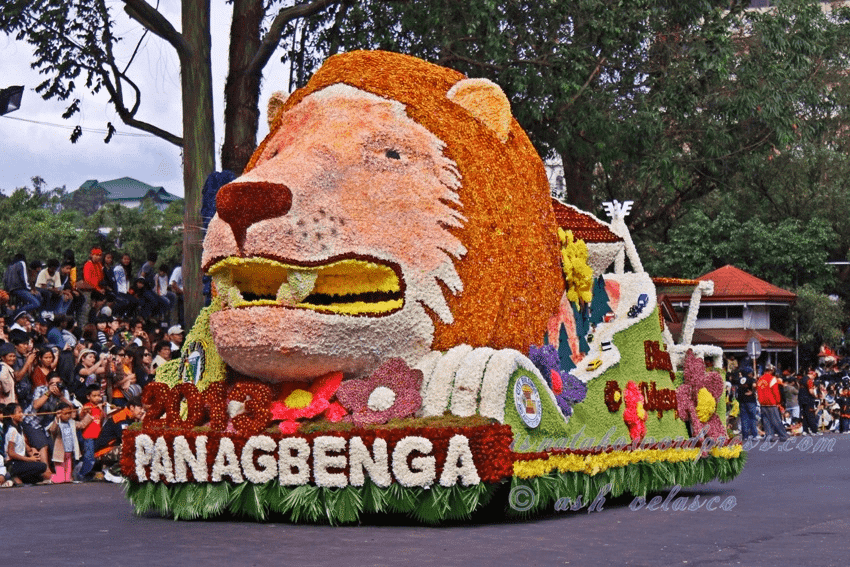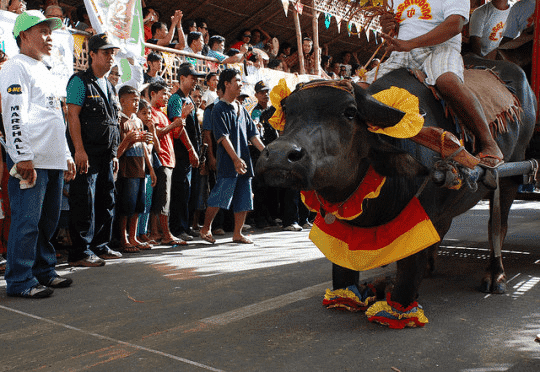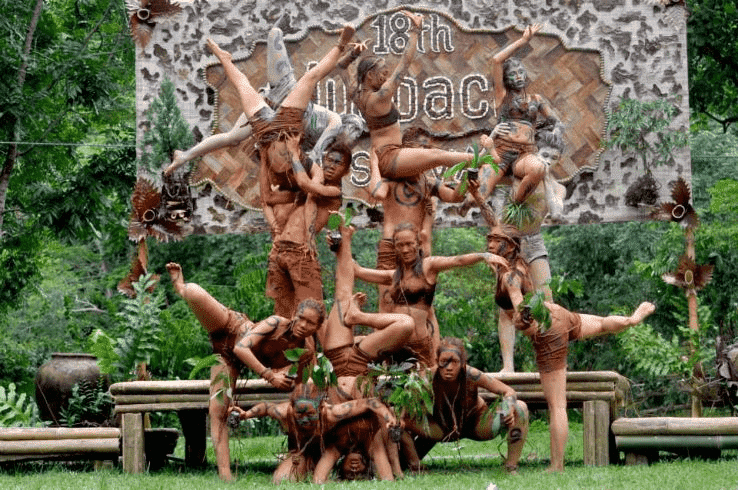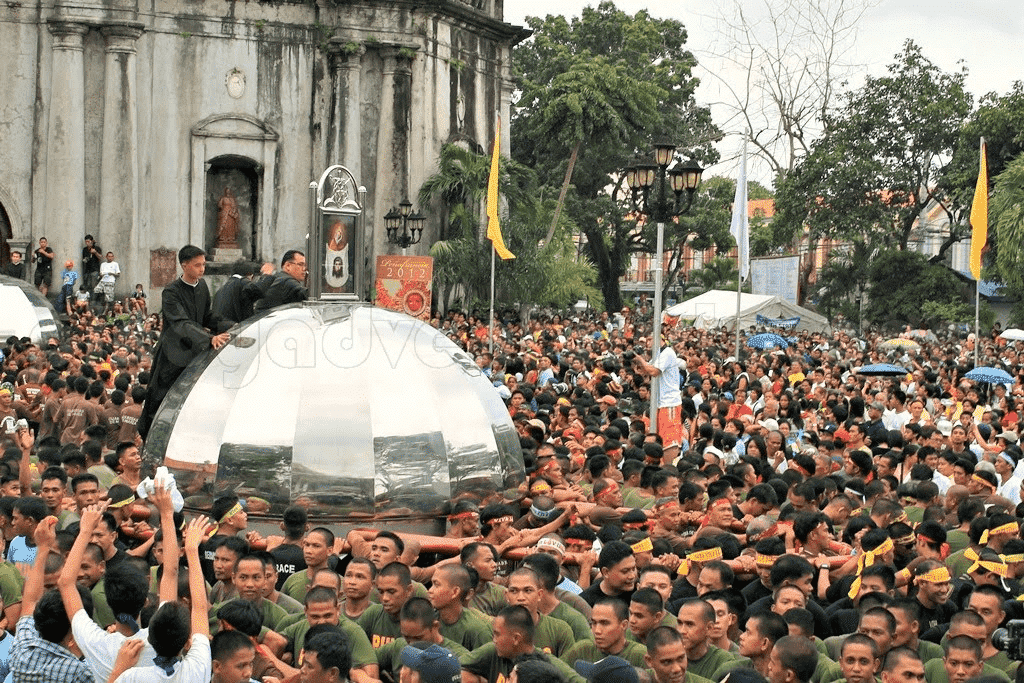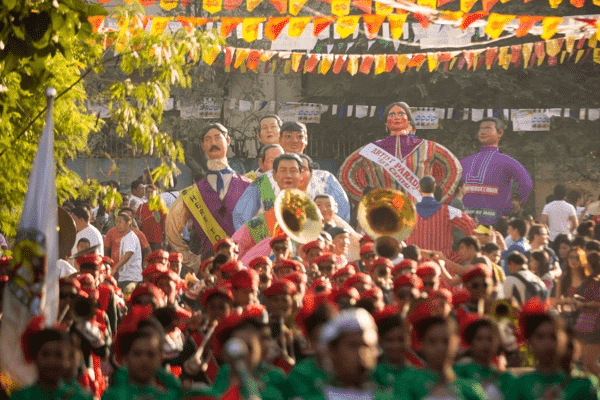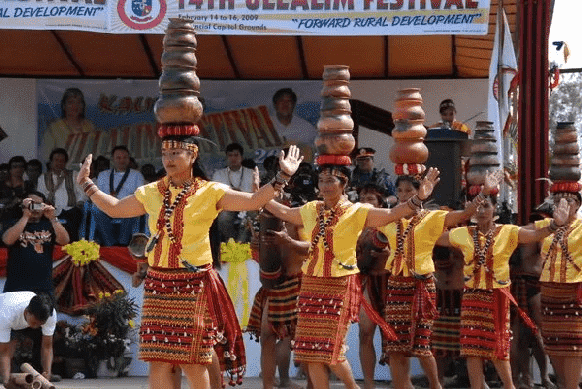Celebrations in the Philippines
The fiesta is part and parcel of Filipino culture. Through good times and bad times, the Filipino fiesta must go on. Each city and barrio has at least one local festival of its own, usually on the feast of its patron saint, so that there is always a fiesta going on somewhere in the country. But the biggest and most elaborate festival of all is Christmas, a season celebrated with all the pomp and pageantry the fun-loving Filipinos can manage. The Philippine fiesta is a lot more than it seems on the service. It is the tie that binds Filipinos from a region or an area together, a time to reunite with your extended family and your kababayans (countrymen/women.)
No matter where you are, you are expected to attend. It is a time to rejoice in friendship, spend all you have, forget the expenses, and just be happy you can afford to entertain and feed others if you can. Below are the major Philippine Fiestas / Festivals:
Below are the major Philippine Fiestas / Festivals:
Note: Dates can be moved a few days before or after.
FEAST OF THE BLACK NAZARENE
Quiapo, Manila – January 9th
A grand Fiesta, this festival centers on the image of the Black Nazarene which was transported by galleon from Mexico to Manila in the 17th century. The festival is marked by an afternoon procession by thousands of devotees.
ATI-ATIHAN
Kalibo, Aklan – January 16-22
The vibrant Ati-Atihan Festival commemorates the 13th-century land deal between 10 migrating Bornean chieftains and the aboriginal Ati King Marikudo. It also honors the town patron, the infant Sto. Nino.
The ceaseless, rhythmic pounding of drums gets to you, and before you know it you are on the street, shuffling your feet, shaking your head, waving your hands – and joining thousands of soot-blacked, gaily-costumed revelers in an ancient ritual of mindless merriment. A familiar battle cry reaches your ears, and amidst all this confusion you remember where you are: Kalibo, Aklan. “Viva, Sto. Nino!”
The Ati-Atihan celebration is echoed in many parts of the country.
PASUNGAY
SINULOG
Cebu City – Every third weekend in January
Cebu City’s fiesta of fiestas. Characterized by its peculiar two-step-forward-and-one-step-backward shuffle, thus simulating the Holy Child of the shores, the Sinulog is a century-old tradition observed in the part of the Visayas region. The prayer dance is synchronized to the beat of drums and shouts of “Pit Senior! Viva Sto. Nino!” Feel free to dance with the best of them, grooving to the grand final presentation at the Cebu City Sports Center.
ZAMBULAWAN
DINAGYANG
Iloilo City – Every fourth weekend of January
Merry mayhem breaks loose in Iloilo City this weekend when Ilonggos leave everything behind to join in the fiesta of the year. All inhibitions are dropped: boring everyday clothes are exchanged for “Ati” warrior costumes and black body paint. Shields and “weapons” are held amidst the pounding rhythm of drums, the costumed Ilonggos put their best feet forward in celebration of…..Dinagyang!
FEAST OF OUR LADY OF CANDLES
PANAGBENGA - Baguio Flower Festival
Baguio City from February 23 – March 3
It’s flower season in the city of Pines – perfect timing for an all-out fiesta in the streets. The Baguio folk take a break on these days to revel in the cool climate and the unique culture of the city.
Multi-hued costumes are worn, mimicking the various blooms of the highland region (or any of its 11 ethnic tribes). These are flowerbeds – disguised, of course, as the Panagbenga parade floats.
KAAMULAN
Malaybalay, Bukidnon from February 28 – March 1
Expect the Bukidnon to go tribal from the first to the second week of March when the streets of Malaybalay take on that familiar fiesta theme. Banners, banderitas, and beer will be the norm, as well as the sweet, haunting sound of native music. An early morning pamuhat ritual kicks off the festivities, to be followed by an ethnic food fest, trade fairs, and a lot of native dancing.
The fiesta is part and parcel of Filipino culture. Through good times and bad times, the fiesta must go on. Each city and barrio has at least one local festival of its own, usually on the feast of its patron saint, so that there is always a fiesta going on somewhere in the country. But the biggest and most elaborate festival of all is Christmas, a season celebrated with all the pomp and pageantry the fun-loving Filipinos can manage.
PARAW REGATTA
EID-EL-FITR
VIA CRUCIS
Cebu City – April 1
A lenten activity where devotees from Cebu City and its neighboring cities and towns do their penitential procession through cities the Station of the Cross is built on 12 hectares of rolling hills. the life-size statues of the 14 Stations of the Cross have been patterned after the Way of the Cross in Lourdes, France.
PAK'KAAT KALLO
Magpet, Cotabato – Holy Week
An annual feast of the Manobo tribal community of Magpet in celebration of a bountiful harvest.
MORIONES FESTIVAL
Boac, Magpoc, Marinduque – Holy Week
One of the most famous Philippine festivals. Colorfully garbed and masked as Roman soldiers and centurions, locals reenact the life of Longinus culminating in his beheading. The entire towns of Boac, Morpog, and Gasan are virtually converted into huge stages as the story as Longinus unfolds.
CUTUD LENTEN RITES
San Fernando, Pampanga from April 16-18
Prayer of a different meaning during the Lenten season, when villagers of San Pedro, Cutud, engage in the act of self-flagellation. This ancient ritual is performed in the morning of Good Friday during the Holy Week. Backs, arms, and legs are cut and then struck with burillo whips. The climax to this occasion happens at midday when penitents are nailed to their waiting crosses.
TURUMBA
ANG PAGTALTAL SA GUIMARAS
Jordan, Guimaras – Good Friday
Lenten presentation on the hillside of Jordan with locals as actors. This ala-Oberrammergou event has been attracting hundreds of foreign and domestic tourists: Local devotees’ visit usually culminates in the trek to “Balaan Bukid” or Holy Mountain where a huge cross is planted by the chapel overlooking Guimaras Strait and Iloilo City.
LAMI-LAMIHAN FESTIVAL
MANAOAG PILGRIMAGE
PISTA'Y DAYAT
SANTACRUZAN
Nationwide – May 1, 8, 15, 22, 29
The Santacruzan is a procession commemorating St. Helena’s finding the “True Cross”; preceded by a nine-day Novena in honor of the Holy Cross. On the ninth day, usually on a weekend, the Santacruzan is held. The Reina Elena, accompanied by a little boy representing King Constantine, and the other sagalas representing biblical characters and the attributes of the Blessed Virgin, walk under gaily decorated arches.
CARABAO FESTIVAL
PULILAN KNEELING CARABAO
PAHIYAS/MAYON/AGAWAN
Quezon from May 11 to 15
Flowers come out in May, but these aren’t the only things flaunted during this merry month. Down south in the town of Lucban, Quezon, there’s also the kiping – a colorful, translucent rice tortilla that serves as an edible ornament of sorts. You will see lots of these at the Pahiyas Festival, an annual celebration held to usher in a bountiful harvest, and smashing good times.
It’s a free-for-all, grab-all-you-can affair with suman-sweet, sticky native rice cakes-as the center of contention. It is also the grand prize, so feel free to join the fray. Rest assured, whether you get handfuls or just a mere mouthful, the Mayohan sa Tayabas will leave you wanting for more – suman, of course!
Sariaya’s version of the San Isidro festival showcases the creativity and ingenuity of the townsfolk in their craft and culinary tradition.
OBANDO FERTILITY RITES
Obando, Bulacan from May 17 to 19
A three-day fiesta celebration in honor of San Pascual, Baylon, Sta. Clara and Nuestra Senora de Salambao. Childless couples, thankful parents, grateful farmers, and fishermen dance along the streets together with colorfully customed women to pray for children and a good harvest.
TAPUSAN SA KAWIT
Kawit, Cavite – May 30
A procession of gaily decorated floats decked with flowers of Maytime honors the Blessed Virgin. The participation of the town’s most beautiful young ladies symbolizes the purity and innocence of the Blessed Mother.
ANTIPOLO PILGRIMAGE
INDEPENDENCE DAY
PINYAHAN SA DAET
Daet, Camarines Norte – June 15 to 24
Sweet, succulent pineapple is the fruit of choice for the people of Daet, Camarines Norte. They loved it so much that they made a festival in its honor. Join the locals as they celebrate the Pineapple Festival featuring a colorful street presentation complemented by art exhibits, trade fairs, cultural dances, and sports events. Feel rich when you go for a visit to Paracale Gold Mines, and get acquainted with some Bicol heroes like Vinzon Panganiban and Lucban.
MUDPACK FESTIVAL
Murcia, Negros Occidental – June 24
Oneness with nature is the underlying theme behind Murcia’s annual mud-moving spectacle. Check on its murky highlight – a lively street dancing parade with the participants wearing nothing but mudpacks (well, almost…). It’s a surefire way to mix our ecological concerns with good, clean, cloddy fun – just be sure to shower afterward!
PARADA NG LECHON
Balayan, Batangas – June 24
A different sight and flavor are introduced in June with a festival in Balayan, Batangas, popularly known as the “Parada Ng Lechon”. These succulent roasted pork form the highlight of the occasion decked out in their platforms with all kinds of decor. Since the festival coincides with the feast of St. John the Baptist, be prepared to get wet as people observe the feast by repeating the ritual of baptism – pouring water.
PINTADOS FESTIVAL
Tacloban City – June 29
Back during the pre-Hispanic years, tattoos signified courage among the natives of Tacloban. These days they symbolize a cultural revival, and a wild, wacky fiesta called the Pintados. Join the town residents as they deck themselves out in body paint, mimicking the warriors of old while dancing to the frenetic beat of drums.
SANDUGO FESTIVAL
Tagbilaran City – July 1 to 2
The Spanish colonization of the Philippines began with a blood-sealed peace treaty on the shores of Bohol. This historic event is remembered today with an all-out fiesta at the island’s capital city. Check out the Sandugo street dancing parade featuring ten colorfully dressed groups dancing to the beat of drums. There’s also a traditional Filipino carnival, a martial arts festival, and the Miss Bohol Sandugo Beauty Pageant, among the dozen other exciting activities.
BOCAUE RIVER FESTIVAL
PAAWAY SA KABAYO (Horsefight)
KINABAYO FESTIVAL
Dapitan City – July 25
An exotic and colorful pageant re-enacting the Spanish-Moorish wars, particularly the Battle of Covadonga where the Spanish forces under General Pelagio took their last stand against Saracan. They were able to reverse the tide through the miraculous apparition of St. James. The addition of local color and innovation has made this annual revelry a popular attraction that brings thousands of visitors to the city.
RAJAH BAGUINDA FESTIVAL
KADAYAWAN SA DABAW
Davao City – August 20 to 24
Davao’s annual festival, Kadayawan Sa Dadaw promises another weekend of fanfare and fun – tribal style. Watch as the festivities reach a glorious climax on Saturday morning: that’s when the Kadayawan parade is held, featuring colorful, orchid-bedecked floats and more than a dozen “ethnic” groups dancing to the beat of wooden drums.
BONOK-BONOK FESTIVAL & SILOP CAVE ADVENTURE
LEMLUNAY (T'BOLI TRIBAL FESTIVAL)
Lake Sebu, South Cotabato – September 16 to 18
An annual authentic T’boli tribal festival staged at Lake Sebu. Features tribal rituals that start early down amidst sounds of gongs and native music, culminating at the town plaza where cultural dances and ethnic sports like horse fights are held.
FEAST OF NUESTRA SEÑORA DE PEÑAFRANCIA
Naga City, Camarines Sur – 3rd Saturday of September
A religious festival held in honor of the Feast of Our Lady of Peñafrancia. Bicol’s most revered patrons are highlighted by the fluvial procession of the Lady’s image down the Bicol River. The week-long celebration includes a civic-military parade, sports fests, exhibits, cultural shows, beauty pageants, and colorful competitions.
ZAMBOANGA HERMOSA FESTIVAL
Zamboanga City – October 10 to 12
All roads in Mindanao lead to Zamboanga, as the “City of Flowers” celebrates its grand, annual Hermosa Festival. The vintas, those colorful native sea boats, once again make their appearance in a fast-paced, race-till-you-drop regatta. There’s also a wealth of cultural and flower shows, art exhibits, and trade fairs. It’s an all-out celebration of life – Chavacano style!
LA NAVAL DE MANILA
Sto. Domingo, Quezon City – 2nd Sunday of October
A festival revolving around the image of the Blessed Virgin Mary of La Naval carved in 1533 and given as a gift to the Dominican Fathers. Borne on an elaborately decorated and well-lit carriage in the form of a ship, the venerated image is brought out of the church preceded by a dozen or so images of Dominican saints. The procession goes around the main streets of Sto. Domingo parish and then returns to the church amidst applause until it reaches the altar pedestal.
MASSKARA FESTIVAL
Bacolod City – October 14 to 21
The carnival spirit fills the air as masked participants donning fabulous costumes dance their way around the city’s main thoroughfares. This annual event reflects Bacolenos’ love for fun and gaiety. Coinciding with the city’s character day celebration, the festival features carnivals, fairs, and madri-gras-style street dancing.
IBALONG FESTIVAL
Legaspi City – October 19 to 22
A celebration depicting Bicol’s early beginnings as portrayed in the “Ibalong” epic that tells of superheroes Handiong, Batlog, and Oryol and villains and wild animals that roamed in ancient times. In music and dances, revelers parade on the main streets wearing masks of these heroes and villains. Festival activities include tours, trade fairs, exhibits, and beauty pageants.
LANZONES FESTIVAL
Camiguin – October 25 to 28
Camiguin Island’s favorite fruit becomes the object of adoration in this superb street dancing extravaganza. Watch the streets of Mambajao become colorful, lively stages as the Camiguinons strut their stuff; dressed in the costumes of the Mindanao tribes, and carrying bunches of sweet, sumptuous lanzones. Everyone is welcome to join the fun – it is a come-as-you-are, eat-all-you-can, and dance-till-you-can affair.
PINTA FLORES FESTIVAL
San Carlos City – November 3 to 5
This city in the sugar-producing island of Negros Occidental honors its patron saint, San Carlos Borromeo, with a pageant where participants with floral painted bodies dance in rhythmic beat as they wind through the major streets. The festival is inspired by the tattooed Negrenses of pre-colonial times.
FEAST OF SAN CLEMENTE / HIGANTES FESTIVAL
Angono, Rizal – November 22 to 23
Angono’s joyous fiesta in honor of San Clemente whose image, resplendent in papal vestment, is borne by male devotees during a procession accompanied by “pahadores (devotees dressed in colorful local costumes, wooden shoes and carrying boat paddles) and higantes” (giant paper mache effigies) The street event culminates in a fluvial procession in Laguna de Bay amidst revelry that continues until the image is brought back to its sanctuary.
GRAND CORDILLERA FESTIVAL
GIANT LANTERN FESTIVAL
MARIAN PROCESSION
PAGDIDIWATA
SHARIFF KABUNSUAN FESTIVAL
Cotabato City – December 15 to 19
Cotabato City’s Muslim population celebrates the arrival of Islam to the region with a series of fun-filled activities. No need to go native to enjoy these – there’s a fluvial parade, an outrigger boat race, as well as various musical and athletics events.
BIKOL PASTORES
BINIRAYAN FESTIVAL
San Jose, Antique – December 28 to 30
A festive commemoration of an episode in the history of the Filipino race through colorful pageants acted on the beaches of Maybato in San Jose and Malandog in Hamtik. Particularly interesting is the drama of the first Malay settlement at Malandog which runs for several days and nights. Binirayan is also an occasion of reunion with families, relatives, and friends of homecoming Antiqueno expatriates.











